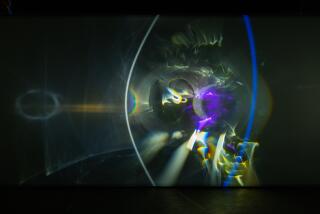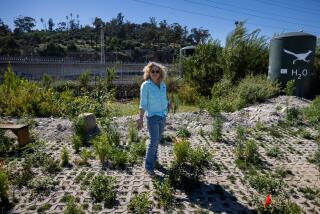Falling for N.Y. waterfront
- Share via
NEW YORK — Like mirages coming to life in a desert, four man-made waterfalls started pouring 35,000 gallons of water a minute into the East River and New York Harbor last week in one of the most ambitious public art projects undertaken in the United States.
Built of simple industrial materials -- construction scaffolding, pumps and pipes -- the waterfalls “give us a new way to see New York,” in the words of one sponsor, by calling attention to the city’s often-overlooked waterfront.
And, attempting to emulate past successful public art projects in New York and other big cities, city officials also hope the unusual spectacle drums up tourist business. The city’s Economic Development Corporation estimates that the project will add $55 million to the city’s economy by the time it ends in October.
Ranging from 90 to 120 feet in height, the cascades are “the most unexpected waterfalls” between Niagara Falls and southern Africa’s Victoria Falls, said New York Mayor Michael R. Bloomberg, who admitted that when he first heard the idea, his reaction was, “What on Earth are you talking about?”
But Bloomberg said that Danish artist Olafur Eliasson had “taken what everyone else sees as the East River and turned it into a triumph of engineering and artistry.”
The project is the biggest public art undertaking in New York since “The Gates” in 2005, when artist Christo and his wife, Jeanne-Claude, decorated Central Park with saffron-colored fabric panels suspended from tall supports.
Eliasson said his brainchild, called the New York City Waterfalls, is meant to draw attention to various aspects of New York’s relationship with its harbor, from transportation and commerce to recreation.
One spindly structure stands beneath the Brooklyn Bridge, and two others rest on piers in Manhattan and Brooklyn, recalling the city’s past as a busy port for passengers and freight. The fourth rises next to Governors Island, site of a former fort that is to be turned into a public park.
Inspired in part by the waterfalls of Iceland, where Eliasson grew up, the artist called waterfalls “a fantastic natural phenomenon,” but added that they are also a way to make people think not only about water but also space because “water falls through space.” He also hopes to draw attention to the importance of water to human life and the environment.
“Making water explicit, making water tangible, makes it possible to engage with water and think about water in the environment,” he said at a news conference at the South Street Seaport in Lower Manhattan, a vantage point from which all four waterfalls are visible.
The waterfalls, which will operate each day until 10 p.m., work by pumping water out of the river or harbor up to the top of the scaffolding and letting gravity take its course.
Despite the simple concept, the project took two years to realize, mainly because of the bureaucratic obstacle course it had to clear. Bloomberg said the waterfalls required permits from 30 federal, state and local agencies.
Screens on the pumps keep fish and other aquatic life from being sucked in, and renewable sources such as wind power provide the electricity to power the machinery and the energy-efficient LED lights that will illuminate the waterfalls after nightfall.
Apart from a $2-million government grant, funds for the $15.5-million project came from private donors, including Bloomberg’s media company, Bloomberg LP. The money was raised by the nonprofit Public Art Fund.
After the pumps are turned off for the last time, Eliasson said, 90% of the materials in the project will be reused or recycled.
During a boat tour of the four cascades Thursday, the artist said he had no regrets that his project will last only four months.
“It’s part of a conversation in the city,” he said. “If it’s there all the time, you have a different conversation. It’s not about making a monument. It’s ephemeral.”
More to Read
Sign up for The Wild
We’ll help you find the best places to hike, bike and run, as well as the perfect silent spots for meditation and yoga.
You may occasionally receive promotional content from the Los Angeles Times.






